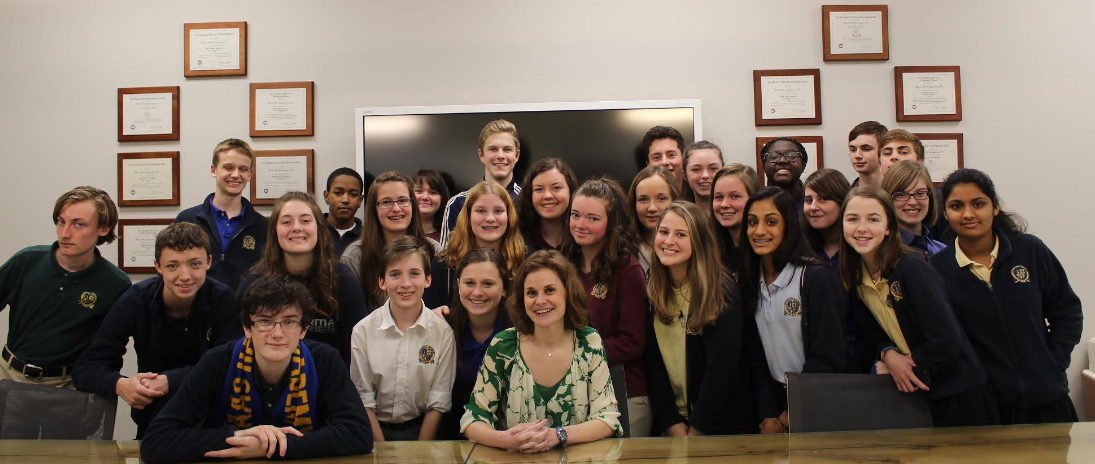Get to Know the 2017 History Teachers of the Year: Rebecca Moll, Arkansas
Posted by Anna Khomina on Wednesday, 10/11/2017
This year, the Gilder Lehrman Institute recognized 52 State History Teachers of the Year for their tireless and innovative efforts to make history come alive for their students.
But who are they, really? We asked these talented teachers to answer a few questions about themselves and to reflect on the challenges and joys of teaching. We will feature a state winner every Tuesday and Thursday, so keep checking back to learn more about these outstanding educators!
This week, meet Rebecca Moll:
 Rebecca Moll, Haas Hall Academy
Rebecca Moll, Haas Hall Academy
2017 Arkansas History Teacher of the Year
Do you have a favorite/funny memory from teaching?I thought I had a brilliant idea to get my students to research and dig deeper into history by having a "Tea Time," so that we could "gossip" about the Harding administration and all of the scandals. It turned out that the assignment coincided with the release of President Harding’s letters to his mistress, Carrie Fulton Phillips. Needless to say high school students found those more interesting than the Teapot Dome Scandal.
State one fun historical fact about the town you live in or grew up in.
The oldest house still standing in Fayetteville, Arkansas, is known as the Ridge House. Sarah Ridge moved to Fayetteville following her husband’s assassination in Indian Territory. Sarah’s husband was John Ridge, a leader in the Cherokee Nation that signed the Treaty of New Echota. When the Cherokee reached Indian Territory, members of the Ross faction set out to assassinate members of the Treaty Party. This left Sarah, her seven children, and their tutor to seek refuge in Fayetteville. As a result of their time in Fayetteville, the children’s tutor, Sophia Sawyer, established the Fayetteville Female Seminary. Sarah’s son John Rollin Ridge went on to become the first editor of the Sacramento Bee and is considered the first Native American novelist, for his book The Life and Adventures of Joaquin Murieta, the Celebrated California Bandit. Sarah and John Ridge are also my great-great-great-great grandparents!
What is the last great history book you read?
Recently, my students and I decided to start a rowing program at our high school, and when we met with the local rowing club, we were advised to read The Boys in the Boat: Nine Americans and Their Epic Quest for Gold at the 1936 Berlin Olympics by Daniel James Brown. It is a wonderful story about the University of Washington rowing team’s unlikely rise to represent the United States at the Berlin Games. American Experience has an episode called Boys of ’36.
What is your favorite historical site or museum?
The Crystal Bridges Museum of American Art has made a big impact on teaching US history in our region. The museum is set up as a timeline of US history from the colonial period to now. Many of the famous painting featured in textbooks now reside in Bentonville, Arkansas. It is a wonderful way to walk through history. My students can see Norman Rockwell’s Rosie the Riveter, Gilbert Stuart’s George Washington, and Theodore Robinson’s World’s Columbian Exposition, as well as work by modern artists like Andy Warhol.
If you could travel back in time and meet any historical figure, who would it be and why?
Chief Justice John Marshall, by far one of the most underrated political figures. The idea of judicial review is one of the greatest American constructs. I would want to thank him for his early rulings to allow the judicial branch to be an independent institution for the people of the United States.
Who is your favorite historian?
Dee Brown, Arkansan and author of Bury My Heart at Wounded Knee.
What is your favorite historical film or series?
PBS American Experience!
Do you have a favorite historical topic or era?
US foreign policy is my all-time favorite topic! Every president has had their own idea on the US involvement abroad, but there is a more complex element when you add Congress and public opinion. Whether it was the Barbary Coast, the Philippines, Vietnam, or Kosovo, each president had a methodology in their decision making. I was fortunate enough to attend the GLI Teacher Seminar at the University of Texas on United States Foreign Policy since 1898, with Professor Jeremi Suri.
Do your students have a favorite historical topic or era?
My students really enjoy reenacting the disputes that led up to the signing of the Treaty of Versailles. The students are paired with the various countries that were negotiating the closure of World War I. They really love the idea of creating an alternate ending that would result in greater strife or peace depending on the actors. Every year, the discussions are heated, and they never end the same. I like activities where you can engage the students in the idea of conflict resolution—that historical events are more complex than what is written on a page.
